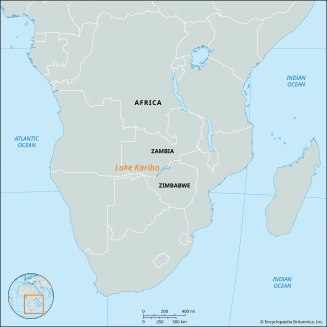Description

Copyright infringement not intended
Picture Courtesy: https://www.worldbank.org/en/region/afr/brief/the-kariba-dam-rehabilitation-project-fact-sheet
Context: Drought affected Lake Kariba in Zimbabwe, impacting both human communities and wildlife in the region.
Impact on Local Communities
- Survival and Livelihoods: Fishermen rely directly on Lake Kariba for their livelihoods. Reduced water levels lead to diminished fish spawning areas, resulting in lower catches and economic losses. Increased human-crocodile conflicts as crocodiles raid fishers' nets, prompting retaliatory actions that endanger fishers.
- Human-Wildlife Conflict: Water scarcity drives wild animals closer to human settlements in search of water, leading to heightened conflicts between humans and wildlife over limited resources.
- Poaching: Wildlife encroaching on human habitats increases opportunities for poaching as animals seek water and food, exacerbating conservation challenges.
- Tourism Decline: Reduced water levels disrupt wildlife habitats and limit tourist activities like game drives and fishing, impacting local tourism revenues and employment.
- Water Access: Decreased water levels necessitate longer journeys for women and children to collect water, posing risks from encounters with wildlife and straining daily life.
- Trade Disruption: Cross-border traders face economic challenges due to reduced fishing opportunities, impacting livelihoods and regional trade dynamics.
Government Interventions
- Renewable Energy Transition: Invest in renewable energy projects like wind and solar to diversify energy sources and reduce dependence on hydroelectric power during droughts.
- Wildlife Management: Implement strategies to mitigate human-wildlife conflicts, such as directing human activity away from high animal activity zones and increasing public awareness.
- Traditional Practices: Support local traditional rainmaking ceremonies to promote community resilience and preserve cultural practices associated with water management.
- Community Engagement: Involve local communities in water governance and decision-making, leveraging indigenous knowledge to adapt to changing environmental conditions.
- Capacity Building: Provide resources and training to communities for sustainable water use and conservation practices during drought periods.
- Cross-Border Collaboration: Coordinate with neighbouring countries like Zambia to address shared challenges related to water resource management and conservation.
Lake Kariba
- Lake Kariba, situated between Zambia and Zimbabwe, is the largest artificial lake and reservoir in terms of volume globally.
- It was formed by the construction of the Kariba Dam across the Zambezi River; it serves vital functions ranging from hydroelectric power generation to supporting diverse ecosystems and local communities.
- Lake Kariba hosts diverse fish populations, including the introduction of kapenta (similar to sardines) from Lake Tanganyika, which has spurred a thriving commercial fishery.
- The lake sustains a rich ecosystem with notable inhabitants such as Nile crocodiles, hippopotami, and gamefish like tigerfish.
- The surrounding areas are home to large terrestrial mammals, including elephants, lions, cheetahs, leopards, buffaloes, and numerous plains game species.

Must Read Articles:
EL NINO ONSET
Source:
Down to Earth
|
PRACTICE QUESTION
Q. Which two countries border Lake Kariba?
A) Zambia and Zimbabwe
B) Zambia and Malawi
C) Zimbabwe and Mozambique
D) Botswana and Namibia
Answer: A
|













